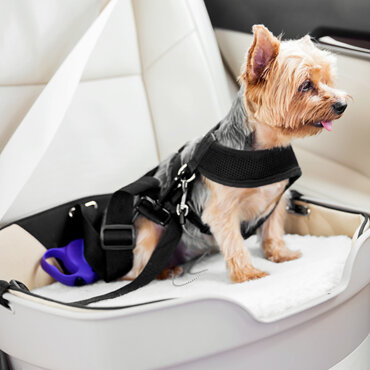Dogs look so happy and carefree, with their ears blowing back, as they hang their heads out the window of travelling cars, but travelling with an unrestrained dog can be a real risk – to them, to you and to other drivers.If you’re on the road with your dog, here are some tips to keep you all safe.
- There are no laws requiring people to restrain dogs within cars, but the New Zealand Road Code does stipulate that holding a package, person or animal in your lap or arms when driving is dangerous.
- Dogs are not permitted to travel unsecured on the back of trucks, utes and trailers. You must either put your dog in a cage on the back of the vehicle, or secure it to the vehicle with a rope or leash. The rope or leash must allow the dog to stand and lie down in a natural position and prevent the dog from getting its legs over the side of the vehicle. The exception to this rule is farm dogs. They are permitted to be loose on the back of vehicles on public roads, but only if they are actively working.
- We recommend restraining your dog while travelling. It will keep them safe and secure should an accident occur and it will stop them from distracting the driver by moving around the vehicle and potentially blocking the driver’s view.
- Vehicle restraints for dogs include a travel carrier/cage (for smaller dogs and short journeys) or a specially designed harness which attaches to the seatbelt. If you choose a travel cage, place it in the footwell of the front passenger seat, or secure the cage with a seatbelt in the rear seat. If you choose a harness, it should be properly fitted in the rear seat of the vehicle and secured with a seat belt. The harness should be adjusted so there is sufficient room for your dog to comfortably move, but not so loose that they can escape. We stock a full range of ‘Yours Droolly’ Car Safe Two in One Safety Harnesses.
- Larger dogs may be more comfortable travelling in the boot of a hatchback vehicle. In this case, it is recommended that you use a cargo barrier to stop them jumping over the headrests.
- Make your dog comfortable for travel. Put blankets and their favourite toy into carriers or cages. If you are going on a long journey, plan regular stops for walks, snacks, toileting and stretching.
- Make sure you keep your dog on a lead as they get out of the vehicle – if they’re in an unfamiliar place. with other people and traffic around, they may panic and run away.
- Regulate the temperature in the car.
- Lastly, never leave your dog in a warm car. Temperatures can quickly rise, even on cooler days, leading to heatstroke, dehydration or even death.
Dr Linda Sharp – Pet Vet at Franklin Vets Pukekohe




